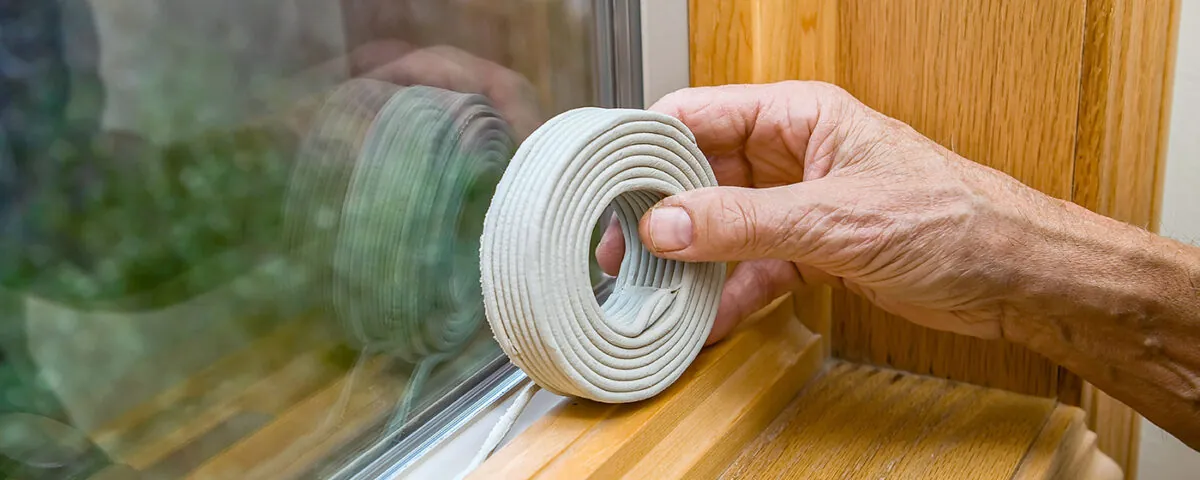
You should use weatherstripping in your home or business to seal air leaks around movable building components – like windows and doors.
As your trusted energy expert, we’re here to help give guidelines on how to be more energy efficient to save energy use and cost. Read more below to learn about weatherstripping with this information from the US Department of Energy.
The weatherstripping you choose should seal well when the door or window closes while allowing it to open freely. But you’ll need to choose a type of weatherstripping that can withstand the friction, weather, temperature changes, and wear and tear that comes with its location.
There are many types, and all have their own best uses, advantages, and disadvantages. Understanding the differences will allow you to choose the best product for each specific location. And you can use more than one type of weatherstripping for one area if it is an irregularly shaped space.
The information below can help you select the right solution by comparing common types of weatherstripping.
| Weatherstripping | Description | Best Uses | Cost | Advantages | Disadvantages |
| Tension Seal | The shape of the material creates a seal by pressing against the sides of a crack to block drafts. Often vinyl or bronze. | Inside the track of a double-hung or sliding window, or the top and sides of doors. | Moderate and depends on the material used. | Durable, invisible when in place, and very easy to install. | Surfaces must be flat and smooth for vinyl. Corners must be snug to install. Can increase resistance in opening/closing. |
| Felt | Plain or reinforced with a flexible metal strip. | Around a door or window, or can be fitted into a door jamb. | Low | Easy to install and inexpensive. | Low durability. Least effective at preventing airflow. Must be stapled, glued, or tacked into place. Do not use where exposed to moisture or where there is friction or abrasion. Very visible. |
| Reinforced Foam | Closed-cell foam attached to wood or metal strips. | Door or window stops, bottom or top of window sash, and bottom of door. | Moderately low. | Effective sealer, scored well in wind tests, and rigid. | Can be difficult to install. Must be sawed, nailed, and painted. |
| Tape | Nonporous, closed-cell foam, open-cell foam, or ethylene propylene diene monomer (EDPM) rubber. | Top and bottom of window sash, door frames, attic hatches, inoperable windows. Good for blocking corners and irregular cracks. | Low | Extremely easy to install, works well when compressed, inexpensive. | Durability varies greatly with material used, but not especially high for all. Use where little wear is expected. |
| Rolled or Reinforced Vinyl | Pliable or rigid strip gasket attached to wood or metal strips. | Door or window stops, top or bottom of window sash, or bottom of a door (rigid strip only). | Low to moderate. | Relatively easy to install. Automatically retracting sweeps also available. | Visible. Can drag on carpet. Automatic sweeps are more expensive. |
| Magnetic | Works similar to refrigerator gaskets. | Top and sides of doors, double-hung and sliding window channels. | High | Very effective air sealer. | Installation can be tricky, fairly expensive, & very visible. |
| Tubular Rubber & Vinyl | Vinyl or sponge rubber tubes with a flange along length to staple or tack into place. | Around a door. | Moderate to high. | Effective air barrier. | Self-stick versions are challenging to install. |
| Reinforced Silicone | Tubular gasket attached to a metal strip that resembles reinforced tubular vinyl. | On a doorjamb or a window stop. | Moderate to high. | Seals well. | Installation can be tricky. Hacksaw is required to cut metal. Butting corners can pose a challenge. |
| Door Shoe | Aluminum face attachment with vinyl c-shaped insert to protect the door. | To seal space beneath doors. | Moderate to high. | Sheds rain on the exterior, durable. Can be used with uneven opening. | Fairly expensive, installation moderately difficult. May require door bottom planning. |
| Bulb Threshold | Vinyl and aluminum | Door thresholds. | Moderate to high. | Combination threshold and weatherstrip, available in different heights. | Wears from foot traffic. |
| Frost-brake Threshold | Aluminum or other metal on exterior, wood on interior, with door-bottom seam and vinyl threshold replacement. | To seal beneath a door. | Moderate to high. | The use of different materials means less cold transfer. | Moderately difficult to install, involves threshold replacement. |
| Fin Seal | Pile weatherstrip with plastic Mylar fin centered in pile. | For aluminum sliding windows and sliding glass doors. | Moderate to high. | Very durable. | Can be difficult to install. |
| Interlocking Metal Channels | Enables sash to engage one another when closed. | Around door perimeters. | High | Exceptional weather seal. | Very difficult to install as alignment is critical. To be installed by a professional only. |
Weatherstripping supplies and techniques range from simple to technical.
Determine how much you’ll need by adding the perimeters of what needs to be weatherstripped, then add 5-10% to accommodate any waste. Always measure twice to cut once!
Follow these additional installation guidelines.
Source: Dept. of Energy.